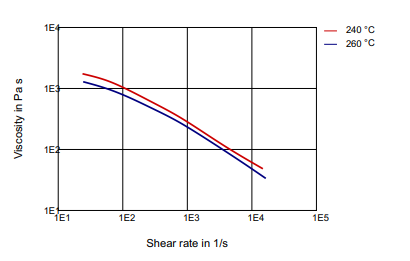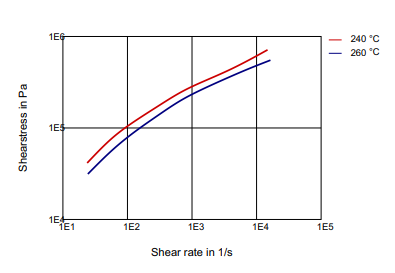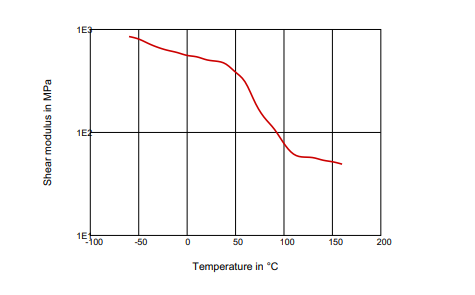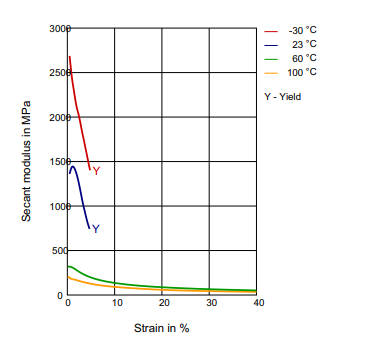Enhanced TDS
Identification & Functionality
- Blend
- No
- Chemical Family
- Country of Origin
- Plastics & Elastomers Functions
- Product Code
- MITM15694
- Single Ingredient
- Yes
- Technologies
- Product Families
Features & Benefits
- Labeling Claims
- Materials Features
Applications & Uses
- Plastics & Elastomers End Uses
- Plastics & Elastomers Processing Methods
- Markets
- Applications
Properties
- Physical Form
Technical Details & Test Data
- Test Data
Viscosity-Shear Rate

Shearstress-shear Rate
Dynamic Shear Modulus-Temperature Stress-Strain


Secant Modulus-Strain

Packaging & Availability
- Packaging Type
Principal Information
- Group Principal Number
- S000003
- Principal
Other
- Color (SDS)
- Translucent
- Insoluble in (SDS)
- Water
- Item Number
- Other Hazards
- Processing may release vapors and/or fumes which cause eye, skin and respiratory tract irritation, Contains high molecular weight polymer(s). Effects due to processing releases or residual monomer: Irritating to eyes, respiratory system and skin, Prolonged or repeated exposure may cause: headache, drowsiness, nausea, weakness, (severity of effects depends on extent of exposure) , Handle in accordance with good industrial hygiene and safety practice. (pellets/granules) This material may contain residual caprolactam monomer. This product may release fume and/or vapor of variable composition depending on processing time and temperature.
- Temperature Control
- Yes
- USA/DOT UN Number
- Not Applicable
- Electrical Properties
Value Units Test Method / Conditions Comparative Tracking Index 600.0 - IEC 60112 condensed - Mechanical Properties
Value Units Test Method / Conditions Charpy Impact Strength 35.0 kJ/m² kJ/m² ISO 179-1EA at 23°C, condensed, notched Charpy Impact Strength 29.0 kJ/m² kJ/m² ISO 179-1EA at 23°C, dry, notched Charpy Impact Strength 11.0 kJ/m² kJ/m² ISO 179-1EA at -30°C, condensed, notched Charpy Impact Strength 11.0 kJ/m² kJ/m² ISO 179-1EA at -30°C, dry, notched Dart Drop Impact Strength 313.0 g g ISO 7765-1 dry basis Hardness 66.0 Shore D Shore D Hardness 66.0 HV HV ISO 868 Nominal Strain at Break min. 50.0 % % ISO 527-1 condensed Nominal Strain at Break min. 50.0 % % ISO 527-1 dry basis Nominal Strain at Break min. 50.0 % % ISO 527-2 condensed Nominal Strain at Break min. 50.0 % % ISO 527-2 dry basis Strain 490.0 % % ISO 527-3 dry, normal Strain 410.0 % % ISO 527-3 dry, parallel Strain at Yield 7.0 % % ISO 527-1 condensed Strain at Yield 4.0 % % ISO 527-1 dry basis Strain at Yield 7.0 % % ISO 527-2 condensed Strain at Yield 4.0 % % ISO 527-2 dry basis Strain at Yield 14.0 % % ISO 527-3 dry, normal Strain at Yield 20.0 % % ISO 527-3 dry, parallel Stress 41.0 MPa MPa ISO 527-3 dry, normal Stress 53.0 MPa MPa ISO 527-3 dry, parallel Stress at Yield 36.0 MPa MPa ISO 527-1 condensed Stress at Yield 44.0 MPa MPa ISO 527-1 dry basis Stress at Yield 36.0 MPa MPa ISO 527-2 condensed Stress at Yield 44.0 MPa MPa ISO 527-2 dry basis Stress at Yield 26.0 MPa MPa ISO 527-3 dry, normal Stress at Yield 25.0 MPa MPa ISO 527-3 dry, parallel Tear Strength 150.0 N/cm N/cm dry, normal Tear Strength 25.0 N/cm N/cm dry, parallel Tear Strength 150.0 N/cm N/cm ISO 6383-2 dry, normal Tear Strength 25.0 N/cm N/cm ISO 6383-2 dry, parallel Tensile Creep Modulus 520.0 MPa MPa ISO 899-1 at 1000 hrs, condensed Tensile Creep Modulus 1130.0 MPa MPa ISO 899-1 at 1hr, condensed Tensile Modulus 1400.0 MPa MPa ISO 527-1 condensed Tensile Modulus 1815.0 MPa MPa ISO 527-1 dry basis Tensile Modulus 1400.0 MPa MPa ISO 527-2 condensed Tensile Modulus 1815.0 MPa MPa ISO 527-2 dry basis - Physical Properties
Value Units Test Method / Conditions Density 1040.0 kg/m³ kg/m³ ISO 1183 condensed Density 1040.0 kg/m³ kg/m³ ISO 1183 dry basis Humidity Absorption 2.5 % % ISO 62 dry basis Load/Unload Temperature 84.0 °C °C ISO 75-1 at 0.45 MPa Load/Unload Temperature 50.0 °C °C ISO 75-1 at 1.80MPa, dry Load/Unload Temperature 84.0 °C °C ISO 75-2 at 0.45 MPa Load/Unload Temperature 50.0 °C °C ISO 75-2 at 1.80MPa, dry Melt Volume-Flow Rate 2.16 % % Dry Melt Volume-Flow Rate 235.0 % % dry, temperature Melt Volume-Flow Rate 2.5 cm³/10 min cm³/10 min ISO 1133 dry basis Melting Point 220.0 °C °C ISO 11357-3 at 10°C/min Melting Point 220.0 °C °C ISO 11357-1 at 10°C/min Mold Shrinkage 0.7 % % ISO 2577 normal, dry Mold Shrinkage 0.8 % % ISO 2577 parallel, dry Mold Shrinkage 0.7 % % ISO 294-4 normal, dry Mold Shrinkage 0.8 % % ISO 294-4 parallel, dry Softening Point 118.0 °C °C ISO 306 at 50°C/h, 50N Storage Temperature max. 140.0 °F °F Thickness 3.2 mm mm Dry Water Absorption 7.0 % % ISO 62 dry basis Water Vapor Transmission Rate 60.0 g/m²/24h g/m²/24h ISO 15106-2 at 23°C, 85% relative humidity, dry - SDS Physical and Chemical Properties
Value Units Test Method / Conditions Decomposition Temperature (SDS) 662.0 °F °F Density (SDS) 1.05 g/cm³ g/cm³ at 20°C Melting Point (SDS) 220.0-255.0 °C °C - Shelf Life & Stability
Value Units Test Method / Conditions Shelf Life 24.0 mo mo
